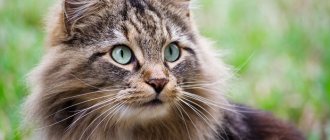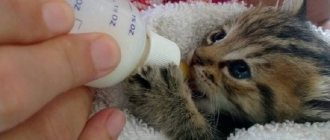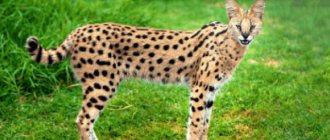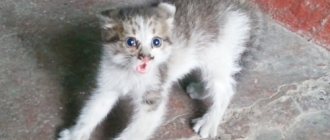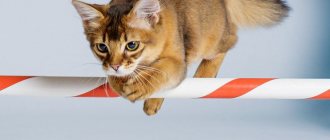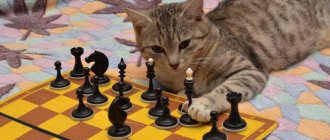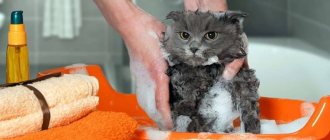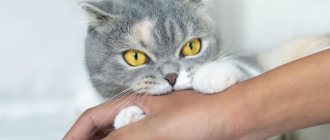Manul
Pallas's cat (Otocolobus manul, Pallas's cat) belongs to the subspecies of small cats and is included in the Red Book because it is an endangered animal. The beautiful thick fur of this predator (up to 7 cm in length) of gray or reddish-brown color with silver tips has made it a desirable prey for hunters for valuable fur. This fur saves animals from frost in their natural habitats. This species of feline hunts birds, hares, marmots, mice, badgers, lives for about 10 years, weighs about 5 kg with a length of 65 cm, and reproduces in the spring.
If you are seriously considering bringing a Pallas's cat into your home, check out the arguments against it:
- Manul is a nocturnal hunter, so he won’t let you sleep at night.
- This type of cat loves space; it is not suitable for keeping in an apartment; it needs a large yard.
- Sheds heavily.
- While playing and sharpening its claws, the animal will ruin all the furniture and curtains in the house.
- He has an aggressive character; neither other pets, nor you, nor your children will get mercy from him.
- It is unlikely that you will be able to find a cat to mate with, or vice versa, and the hormones playing in the spring will drive him into rage and severe aggression.
- Veterinary medicine is not very familiar with Pallas' cats, so in case of illness, it is unlikely that you will be able to find a veterinarian who can cure it.
- You will have to think carefully about the cat’s diet so that he does not get sick and develops properly; regular cat food will not suit him.
- This animal is listed in the Red Book, therefore it is not sold legally, and an illegally imported cat is very expensive (up to 6.5 thousand US dollars), may be infected with some disease or exhausted and exhausted.
There are several reviews on the Internet of people who have domesticated Pallas's cat, but they all note the evil nature of the animal.
Sandy (dune cat)
The sand cat lives in the deserts of Tajikistan, Kazakhstan, the Arabian Peninsula, Uzbekistan, and Morocco and is one of the small breeds of wild cats. The length of the cat without a tail is only 40 cm, its height is no more than 25 cm, and the animal weighs a little more than 3 kg. It has a very thick and very short coat of yellow or cream color, even the soles of its feet are covered with hair. Feeds on small animals. Due to its low population (about 50,000), the sand cat is listed as a protected animal.
Did you know? A sand cat may not drink water for several weeks, hiding in cool places on a hot day.
The following facts speak against your decision to domesticate a sand cat:
- She needs a lot of space, otherwise she may get sick and die.
- There should be dry, warm air in the room.
- The meal should include different types of meat.
- There are only 9 sand cats in the world kept in captivity in zoos, they are great masters of camouflage, making them difficult to catch.
- They have been little studied and are difficult to treat.
- The sand cat will not leave food uneaten, he will hide it: in natural conditions he will bury it, in domestic conditions he will shove it under your pillow or in the sofa.
- It is prohibited by law to catch and keep sand cats at home; an illegally imported animal costs more than 5 thousand US dollars.
Increasingly, exotic animals are chosen as pets: lemurs, salamanders, crocodiles, leopard geckos, snails, iguanas, chameleons, squirrels and jerboas.
Caracal
The steppe lynx (caracal, Lynx Caracal) naturally lives in the sands of the Arabian Peninsula, Asia, Africa, and near the Caspian Sea. These are big cats, the height of a wild animal is about 50 cm, and the length is about 1 m, the cat weighs up to 20 kg. Its fur is thick and short, light brown or brown in color, velvety to the touch, and has black tassels at the tips of its ears.
Important! The caracal is a large animal; in nature, its prey is antelope, so it
can easily kill your child.
These cats also feed on foxes, hares, birds, scorpions, and hedgehogs.
If you decide to keep a caracal, you will have to:
- Build for him a spacious enclosure with special toys, which will definitely have a roof on top, otherwise the cat will simply jump over it.
- Find a veterinarian who can treat him and trim his nails.
- Walk him with a muzzle 2 times a day.
- You can tolerate a dirty cat because you won’t be able to give it a bath.
- During the period of a hormonal surge, endure anger and smell the strong smell of urine, with which the entire apartment or house will be marked.
- Endure pogroms in the house.
- Give up to 800 g of various meats daily for 20 years.
- Pay 10 thousand US dollars for it.
Cat breeds similar to lynx
Maine Coon (Maine coon cat)
These are large domestic cats similar to a lynx, whose popularity makes them the leader in the ranking of demand as a breed.
Externally, Maine Coons are similar to lynxes in terms of ear tufts, size, wild arrangement of stripes and spots on the coat, as well as the structure of the skull. And the breed acquired common features most likely due to long-standing crossing of aboriginal cats with local lynxes. It is difficult to verify this information precisely, because this American breed was initially formed without the participation of a breeder.
The popularity of the breed is high not only because of the special appearance of large cats, but also because of their loyal and peaceful nature. By getting a Maine Coon, you can be sure that you are bringing a loyal and affectionate pet into your home. Its impressive size does not make the breed less graceful in its movements or aggressive; on the contrary, the Maine Coon cat breed is an excellent option to have a cat with the appearance of a lynx, but affectionate and completely tame.
Siberian cat
The distant relationship with the lynx in the Siberian cat breed is guessed in:
- Tassels on ears
- “wild” arrangement of stripes on the muzzle
- Dense wool that warms in cold weather
- The presence of full-fledged down and hair between the little ones on the paws, which allows you to move through the snow without falling through or freezing your toes
Another feature of the breed is its life expectancy. With a caring owner, a Siberian cat can live up to 20 years and be distinguished by its health and inexhaustible energy. It’s nice to have such a cat both in a city apartment and in a private house, where the cat will serve as a mousetrap.
The thick, beautiful long fur of the breed fascinates with its structure and fullness. Running your fingers through the fur of a Siberian cat purring on your lap is a special pleasure.
Norwegian Forest Cat
The similarity of the breed with the lynx is especially visible in cats, whose skull structure reveals distant common ancestors.
The breed also has quite long black tassels on its ears. INTERESTING: in the 1970s, the breed was recognized as the official animal of Norway.
The Norwegian Forest is a breed that has been forming itself for a long time, and at a certain period, crossing occurred between local cats from the forests and Turkish Angoras brought to Europe. It was from these random connections that wild cats received lengthening fur and its delicate structure.
By nature, the modern Norwegian cat is a multifaceted animal. Up to a year old, this is a playful kitten who is happy with all household members and guests. But after full puberty, the animal becomes not a participant, but an observer. The cat will prefer to watch everyone from its house or hanging shelves, and will only go into the arms of the person chosen by the owner. At the same time, the cat is not at all prone to aggression; it is easier for her to run away than to hiss or scratch. Protruding claws is completely out of character for the breed.
American Bobtail
If the American Bobtail has a genetic connection with the wild lynx, then it is very difficult to determine its time frame. However, in appearance the breed is very close to a wild cat:
- Tassels on ears
- Stocky body structure and elongated hind legs
- Short ponytail
- Wild coat color
All this makes it easy to call the breed a variant of the domestic lynx. True, wild appearance has nothing to do with character. The American Bobtail is a very affectionate and devoted cat. And his behavior is closer to that of a dog.
The breed gets along so well with people that it often becomes a pet at clinics and rehabilitation centers, where they give love and attention to patients. At home, a cat of this breed is always in the center of events, even able to get along with any breed of dog and play with it if the owner does not have time right now. He tolerates the harness well and doesn’t mind learning basic commands at all.
Wild cats and hybrids suitable for domestic keeping as pets
Pedigree cats, one way or another, have a conditional resemblance to a lynx, but hybrids and wild species that can adapt to living with humans side by side, and not in an enclosure, are another matter. There are not many such breeds, but they deserve attention if you want a cat that looks like a lynx.
Caracal
Initially, the caracal was exclusively a wild cat, namely a steppe lynx. But the development of civilization and forced proximity to humans gradually formed a population of domestic caracals, which have not lost any of their wild external qualities, but have proven themselves to be an easily tamed cat.
For a long time, due to their external features, caracals were directly classified as a genus of lynx, but when geneticists intervened in the matter, it was decided to separate caracals into a separate consonant genus. The animal itself, naturally, did not react in any way to the decision of the bipeds and remained outwardly similar to its relative - the lynx. Long ear tufts, body structure and dense fur do their part in the perception of a cat’s appearance.
In everyday life, a caracal taken from a special nursery shows itself to be a fairly peaceful and calm pet. He can even live in a city apartment, but with the condition that it is large and that the caracal will be given its own room of 15 square meters, where it will be exclusively its territory. In a private house, you can equip an external enclosure where the cat will have free access, and if necessary, the animal can be temporarily locked in it.
The caracal is so tamed that it can adopt a new cat or puppy into the family. True, the caracal does not favor children; it is better not to have a domestic steppe lynx if you have children under 10 years old.
Caraquet
A hybrid of an outbred large enterprising cat and a female caracal from the enclosure of the Moscow Zoo. The crossing happened by chance and a kitten was born very similar to the mother, but large like the father. Alas, the cat was sterile, but the case so excited felinologists from all over the world that American specialists immediately began breeding the hybrid. Luck smiled in the variant of mating a caracal with an Abyssinian cat. The breed has already received the TICA standard.
Now the Russian woman Irina Nazarova is most actively involved in the issue of establishing a permanent population of hybrids. The complexity of her activities and the activities of her colleagues from other countries is that the caraquet can become a full-fledged breed only by obtaining fifth-generation offspring, and in matters with hybrids of domestic and wild cats this is very problematic. That is why it is now very difficult to purchase a real caracat - there are practically no of them, and there are many more “fakes” with beautiful promises of having a domestic lynx.
Domestic lynx
The domestic lynx is not a breed as such; it is a new hybrid of the Canadian lynx and domestic cats with a similar color.
It is not particularly widespread, since the hybridization process is again very complicated and does not allow for the production of kittens for all lovers of unusual pets. The second difficulty is maintaining the wild habits of the hybrid. The Canadian lynx is still far from being a tame animal, and the first generations of hybrids inherit not only their appearance, but also their habits with heightened instincts.
Maintaining a hybrid is always expensive. The cat will eat only a natural diet; ready-made food will simply be ignored, since a semi-feral cat simply does not understand that the balls in the plate are actually food.
INTERESTING: selection work is underway in Russia to develop the Leohaus breed. These are crosses of hybrids of wild lynxes and cats with a suitable color. The first and second generation offspring have already been obtained.
Savannah
This breed was created artificially by crossing a serval with a domestic cat. And there is one nuance: until the fourth generation, males cannot give birth, and with each generation, the genes of the domestic cat begin to predominate more and more, so only the first generation is valued. This animal has large ears, high paws, and swims well. Savannah grows up to 60 cm in height and up to 1.3 m in length, weighing about 15 kg. Its fur is short and thick, with black spots, and its color is yellow, tan or gray.
Disadvantages of keeping a savannah at home:
- She must be walked on a leash and muzzle.
- She needs a spacious yard.
- She has a highly developed hunting instinct and can eat other domestic animals.
- If the Savannah gets into the bathtub, it will be difficult to get her out of there, not only because of the weight, but also because she will not want to get out, since she loves to swim.
- The male will mark the room, and the smell will remain the same.
- You won't be able to go on vacation or take a day off - the savannah doesn't tolerate strangers.
- If you take a couple of Savannahs in hopes of breeding, it may not work out. In addition to male infertility, there is also this problem: a couple must live together for a very long time before they want to reproduce.
- Savannah sheds heavily.
- Does not tolerate cold well.
- Savannah should be fed raw meat, vegetables and fruits.
- The price of a first-generation Savannah is about 20 thousand US dollars.
One evening, as we were putting our 2.5-year-old twins to bed, my wife was reading to them one of their favorite books, Where the Wild Things Are. Then Juliet, in her Dalmatian pajamas, asked her this question: “Mom, where do the wild animals live?” My wife looked at our tabby cat, who was curled up on a chair next to him. “Yes, Jasper is a wild animal,” she replied. Juliet couldn't believe her ears. “Jasper is not a wild animal,” she countered. “He’s a cat!” The doubts here are quite understandable. Although cats have been with us for almost 10 thousand years and have become the most popular domestic companions in the world, experts still do not have a clear answer to the question of whether they are truly domesticated. In the end, our furry friends don't need us that much: they are able to obtain food by hunting and return to a wild state after losing contact with people. Last year, a scientific paper was published describing some of the genes responsible for domestication: all of them are present in the cat genome. However, its authors call the cat a “semi-domesticated” animal. Some experts categorically disagree with this definition. “There is no difference between a domestic cat and any other domesticated animal,” says Oxford evolutionary biologist Greger Larson, who has studied the domestication of pigs, dogs and a variety of other animals. “Try to convince a goat or ram to spend the night at your house.” Part of the family The main controversial issue concerns our relationship with cats. Although they had divine status in ancient Egypt, after the 13th century, when a paranoid pope declared their connection with witchcraft, cats gained a strong reputation as diabolical, unpredictable and untrustworthy animals. These stereotypes persist even now, as cat videos take the internet by storm. All this raises the following question: are cats akin to dogs (only more inconspicuously) and can perfectly fit into the human family? Or is there something fierce, wild and rebellious about them that will always prevent them from becoming part of our tribe? In other words, are cats with us or against us? This question has plagued lawyers of the past, as I learned while researching Citizen Canine: Our Evolving Relationship With Cats and Dogs, a book that tracks the pets' epic journey from wildness to basket case. in the family living room. In 1894, a Baltimore resident was arrested for stealing his neighbor's cat. But just as the judge was preparing to hand down a guilty verdict, a Maryland prosecutor intervened: “A cat is not property. (...) According to the law, this is the same wild animal as its relatives: the tiger and the wild cat.” The court was forced to release the attacker. The law believed that a cat thief did not steal anything. However, in the early 1900s, as more cats began to appear in homes, the law changed its tune. In 1914, the Maine Supreme Court had to decide whether a man was within his rights when he shot and killed a neighbor's dog while it was chasing his cat. According to the shooter, the law allowed the killing of a dog that could “bother, injure or kill a domestic animal.” But does a cat fit into this category? After much deliberation, the court decided yes: “No other animal has such a strong connection to home. A cat is a pet." Genetic changes Be that as it may, scientists still do not have a consensus. This is partly due to the fact that they still cannot define the concept of “home”. Some believe that this is limited to domestication and the ability to live with people for generations: cats easily fit into these criteria. Others propose more stringent standards: genetic changes and complex behavioral systems that radically change the animal. But does this apply to cats? Biologist Wes Warren of Washington University in St. Louis believes not. He was the lead author of a study of the cat genome published last year and primarily raises the question of agreeableness. Yes, he says, there are affectionate and quiet cats, but there are also nervous and aggressive ones among them: their behavioral spectrum is much wider than that of dogs. He is also dissatisfied with the cats' too much independence. “Cats only seek your attention when they want it,” he explains. “For the most part, they get along just fine without you.” After all, if an animal does not need us, can we say that it has been domesticated? (Maybe not: scientists today think that cats domesticated themselves). One should not discount the fact that, to the great dismay of ornithologists and other lovers of wild fauna, domestic cats hunt a little worse than their wild ancestors. "Dogs don't have this tendency," Warren says. “It was lost in the process of domestication.” In addition, he talks about differences at the genetic level: “If you look at the molecular signatures of domestication, the dog has 10 times more of them than the cat.” Perhaps the fact is that dogs live with people longer than cats: 20 thousand years, according to some estimates. As Warren points out, our pets should be considered more of a subspecies of wild cat, while dogs are a separate species. Behavioral changes Greger Larsen disagrees. As proof, cats can be just as obedient as dogs: “You can easily find cats that are much more affectionate than dogs and seek more human attention.” According to him, upon coming into human society, enormous changes occurred in the behavior of cats. Unlike their wild ancestors, which the naturalist Herbert Brooke once called “the most inhospitable of all living things,” domestic cats are real “sponges that absorb care and give love” (as Hemingway said), purring furries that are much more interested in lounging around. you on your knees than to scratch your eyes out. Scientists even suspect that cats have developed a special purring and meowing sound that they use when communicating with people (their intelligence may have also increased, but it is very difficult to prove anything here, because studying cats is sheer torture). As for the genetic traces of domestication, Larson attributes the differences between cats and dogs to intensive breeding of the latter over 150 years, rather than to any fundamental differences in the domestication process. According to him, all the talk about the “semi-domestication” of cats just reflects age-old stereotypes about the strangeness of these creatures. “We don’t like loners,” he says. “And that’s why it’s much easier to see ourselves in dogs.” So what are cats, domestic or wild animals? Let me tell you another story about Jasper. For Thanksgiving, our whole family (including two cats) went by car to visit my in-laws. The sister-in-law's clan was also there with two boys aged two and five. One morning we all found ourselves in the basement. My children screamed with joy at the sight of a toy train rushing along the tracks, their cousins rode bicycles around the room, and adults talked loudly, trying to shout over the whole circus. Sitting in the corner on the sofa, Jasper first watched us, and then calmly fell asleep. Cats are descendants of the most dangerous predators in the world. They may be quiet and mysterious, but they know how to adapt to a cruel world: when in danger, they growl and arch their backs, their eyes glow, ears flattened, and fangs exposed. In the garden they are the kings of the jungle. However, they give it all up to keep company with us, noisy, unpredictable, and sometimes completely incomprehensible creatures. When they cross the threshold, the wild beast remains behind. They tame us as we tame them. Cats may still have some of their wild heritage, but they always come home.
InoSMI materials contain assessments exclusively of foreign media and do not reflect the position of the InoSMI editorial staff.
Ocelot
This predatory cat (field tiger, Leopardus pardalis) lives in the tropics of America and is similar to a leopard. He has a large head, strong paws, and well-developed muscles. The ocelot grows up to 0.5 m in height and up to 1.5 m in length, and weighs about 15 kg. The fur is very thick and short, light brown with black spots, white on the belly and neck, black ears, each cat has an individual pattern. Their population is endangered.
You should avoid breeding ocelots at home for the following reasons:
- The ocelot has a secretive nature and will not need your company.
- An ocelot will need about 0.5 kg of raw meat per day.
- For better taming, you should take a kitten that is still blind and feed it using a pacifier.
- For maintenance you will need a very high enclosure with an area of at least 15 m2 with a pool and trees.
- The ocelot marks its territory and does not allow anyone into it.
- He doesn't get along with other animals.
- Capable of harassing you with mating cries.
- The hunting instinct is well developed.
- A very proud cat.
- The cost of an ocelot is about 4 thousand US dollars.
Important! An ocelot should not be given raw pork; it may get sick and die.
Description: what does it look like?
In appearance, the wild animal resembles breeds of domestic cats that are gray in color. The difference lies in the tail, which is short and fluffy, as well as in the ears, they have the shape of a triangle, but there are no tassels, like those of a lynx. Cats have very beautiful thick hair of medium length, and unlike domestic animals, they shed only 2 times a year.
Field seals have average weight and height, the female is more fragile, its length varies up to 40-60 cm, males are larger, approximately 90-95 cm.
The European wild cat differs from other felines in its color. The animal's coat is decorated with black stripes, which are located on the croup, frontal part of the head and tail. Striped inserts or large dark spots can be observed on the belly and paws of the savage. Cats have five toes on their front paws and four on their hind paws, as well as sharp claws that are released from their sheaths with lightning speed in moments of danger. Kotofeys are armed with sharp teeth, the front fangs are sharp and have the power to tear apart the intended victim in a matter of minutes. The tongue is covered with curved pimples, with the help of which the animal grooms its fur. The gray semi-wild cat, according to scientists, is the most difficult to train and refuses to make contact with people; sometimes taming a tropical feline is much easier than getting along with a forest animal.
Asian leopard (ALK)
These predatory cats live alone and are common in tropical forests in many Asian countries. Externally, in accordance with the name, they are similar to a leopard, but the size of a domestic cat - no more than 8 kg in weight and 40 cm in height, although there are also larger animals. The color of the coat is different, from yellow to gray, with black spots.
Disadvantages of domestication:
- Aggressive behavior during sexual desire.
- The temperature for keeping should not be lower than 20°C.
- You need to play with the animal, it should have a lot of toys.
- The Asian Leopard Cat should eat 1 live rat or two mice every day.
- Needs walking.
- The animal is very jumpy, your curtains will be torn and your vases will be broken.
- You need to adopt a small kitten.
- These cats are monogamous and live in pairs all their lives.
- Cost - about 4 thousand US dollars.
It is best to have cats at home of the following breeds: Scottish Fold, Munchkin, Burmese, Persian, Siamese, Burmese, Ragdoll, American Curl and Masquerade.
Pampasskaya
This cat is also called the grass cat (Leopardus pajeros), lives in nature in the steppes of South America, is similar in size to its domestic relative, but looks larger. She has long hair (up to 7 cm) of gray, yellow or brown color, black or dark ears, a thick and long tail, and large ears.
Reasons why it is better not to keep her at home:
- The Pampas cat does not allow anyone into its territory.
- Leads a nocturnal lifestyle.
- Little studied.
- Prefers privacy.
- He steals all the birds from his neighbors.
- Doesn't adapt well to domestication.
- Listed in the International Red Book.
- The cost is about 1,000 US dollars.
Breed overview
1 – American Curl
This quiet and affectionate cat breed from the USA is blessed with cute, upturned ears. The breed comes in two subspecies: semi-longhair and shorthair. Semi-longhaired individuals are valued even more highly and are more readily bred, since the appearance of the longhaired American Curl is more impressive and kittens are sold at a higher price.
In everyday life, the breed is peaceful, gets along well with dogs and other cats, and is patient with children. The downside is that the structure of the toes allows an inquisitive cat to penetrate into all closets; the cat’s surprisingly tenacious and dexterous paws will leave no restrictions for your pet.
The breed is in good health, its dense cartilage requires careful handling, but genetically it does not affect the bones and joints in any way, as is usually the case in breeds with mutations.
The price for a kitten starts from 25,000 rubles; you can buy a purebred cat in the USA. Red and chinchilla specimens are considered especially valuable, where the price tag even for the breeding class starts from 40,000 rubles.
2 – Asherah (savannah)
The most expensive cat in the world - the Savannah or Asherah - is a hybrid. The spectacular breed was developed in the USA and looks very similar to a wild serval with notes of a Bengal cat. But the breed’s character is very domestic; the cat’s habits are even more like a dog’s than the average cat’s.
The active character, intelligence and devotion allow the owner to practice agility in a simplified form, learn commands and practice ball games. Ideally, if the Savannah has a dog at home for company, this way the hybrid will be easier to accept training and will be able to adopt the dog’s complaisance.
If you have an Asher in an apartment, then keep in mind that the cat needs the same amount of exercise as the average dog. A harness and daily walks in the park will be vital for your beautiful pet.
The price of a hybrid depends on the generation and pedigree. Usually the price tag starts from 500,000 rubles.
3 – Bengal cat
If you have long wanted not only a loyal, but also a stylish cat for your home, then take a closer look at the Bengal cat, a generally recognized hybrid with an appearance close to a leopard.
The hybrid breed was created and is still being worked on by the American Jane Mill, who since the 1980s has been implementing her idea of creating a domestic hybrid of the Malaysian leopard cat and domestic cats of a suitable genetic type.
The hybrids of her selection are still unstable in appearance, which is why “successful” specimens are very expensive. After all, at the end of the day, you get not just a beautiful pet, but also an intelligent companion, capable of training and devoted to the family. At the same time, Bengal cats do not like to be petted as cats usually do; the Bengal will prefer conversation to any stroking. The cat knows how to listen and actively purrs in response; it will only help if it wants to.
4 – British Longhair cat (Lowlander)
For a long time, long-haired British cats were considered a genetic defect of the short-haired breed, but there are connoisseurs for everything unusual. Already in the 19th century in Europe, long-haired individuals began to be purchased from breeders not just as a marriage, but as the beginning of a new breed. Now British Longhairs are rare guests at exhibitions, but this is only due to the fact that the breed is small in number and so far has only a new breed standard in TICA.
The breed's character is just as calm and phlegmatic as the short-haired one. Tactile tenderness does not cause a response; the Lowlander is more of an observer cat than a participant. In the family, most likely, he will choose a person who will be allowed a little more in his relationship with the cat than everyone else.
The price for a kitten with a pedigree starts at 50,000 rubles. True, on private message boards you can find kittens for 15,000 rubles, but this is either a complete fake, or a marriage in the litter of a short-haired pair, to which no one will give any pedigree and will not classify it as a breed.
5 – Himalayan cat
The most beautiful rare breed of cats, obtained as a result of mating Siamese cats and Persians. The most valuable individuals are blue-eyed cats with a clear Siamese color of a lilac or chocolate shade and a fluffy long fur coat like a Persian cat.
The Himalayans have a special character, unlike any of their predecessors. This is an affectionate, active cat that does not tolerate loneliness very well.
The price greatly depends on the color, the pedigree should always be available and do not hesitate to ask for all the documents for the litter and the parents. The price tag starts at 30,000 rubles for mediocre but purebred kittens of the Himalayan breed.
6 – Yorkie Scottish cat
A very rare and very expensive cat breed, obtained as a result of random crossing and subsequent selection to consolidate the appearance. The cat came out extraordinarily beautiful, completely black. Only the color of the yellow iris differs from the black coat, nose and paw pads.
The difficulty of breeding is associated with the uncertainty of the original breed base and the instability of the total black gene mutation. However, the Yorkie cat has standards in all major phenological associations.
The price for a kitten varies around $1,000, but you can only buy this beauty in the USA.
7 – Kao-mani
The ancient “Book of Cat Poems” from Siam contains some of the first mentions of this snow-white breed of aboriginal cats. The fact that Khao Mani cats have always been considered pets exclusively for the nobility of Thailand helped the breed maintain its original appearance. A cat with a white coat has always been dear and honorable.
But, despite its centuries-old history, the breed has observed status and is not represented at exhibitions. However, connoisseurs of the breed breed graceful cats and the price tag for a kitten is very high. Individuals with different eye colors and a uniform white color without any shades or ticking are especially valued.
8 – Caracal
The caracal is a wild cat, a close relative of the puma, but with a long history of cohabitation with humans. Today, you can buy this wild cat in a special nursery, where more than one generation of kittens has been raised with a clear understanding that a person is a friend and owner.
It’s true that raising a tame cat still won’t work. Your expensive pet will need both your constant attention to maintain socialization skills and a spacious enclosure to unleash its wild cat instincts. At the same time, it is quite easy to accustom a caracal to walking on a leash and basic commands.
9 - Laperm
The breed has a telling name - the cats' fur curls in beautiful waves and most often curls into rings like that of a young lamb. This breed was given to people by Mother Nature herself, at whose whim one day a curly-haired cat was born on a farm in Oregon. She brought offspring as cute as herself, which attracted the attention of her owners, and later the whole world.
Buying Laperm is very problematic. Rare curly cats are bred in the USA and South Africa; there is only one breeder in Moscow. The price, like all rare breeds, depends more on the quality of the pedigree than on the appearance. You need to focus on 350-400 dollars per baby.
10 – Maine Coon
The Maine Coon cat breed is not only one of the top expensive cat breeds in the world, but also breaks all records for popularity and fame. Its size brought such success to the breed. Among domestic breeds, Maine Coons are the largest cats, the weight of an adult male reaches 12 kilograms, although cats usually weigh only 4-5 kilograms.
But it’s not only the gigantic size that wins the hearts of millions of owners. This native North American breed has a fabulous character. Maine Coons are very gentle cats, they become attached to their family with all their hearts and try to spend a lot of time with their household members. The Autumn breed also gets along well with other cats and dogs; even aggressive breeds eventually begin to become friends with the calm Maine Coon and behave very reservedly and friendly when communicating with him.
11 - Manx
Manx are cats without an important “document” - a tail. The breed was independently cultivated for a long time on the British Isle of Man, where several congenital mutations led to a full-fledged population of cats without a tail.
The value of the breed is based on the stability of the mutation, because if the gene for a short tail gets to the kittens from both parents at once, the litter dies. The difficulty of breeding just affects the price for a healthy kitten, without spinal malformations, but with a short tail or no tail at all.
12 - Nibelung
The Nibelungen is a hybrid breed obtained from a Russian Blue cat and a black mongrel cat. Rare representatives of the breed inherited long gray hair with a silver tint and emerald eyes. It is noteworthy in appearance that there is a difference in the length of fur between cats and female cats. Girls in the breed are uniformly fluffy, while boys have a distinct mane with a fluffy collar and panties on their hind legs.
Fog cats inherited their character from Russian blue cats. They choose their own person in the family, but treat the rest quite indifferently. The breed is obedient and can be trained well by its owner. Nibelungen cats are constant, moving, changing surroundings, being away from family for a long time - all this causes a lot of stress.
13 – Ocelot
The ocelot belongs to the wild small cats and captivates not only with its colors, but also with its expressive large eyes that look into the very heart. The fact of their high level of domestication to life in captivity allows them to be considered one of the most expensive wild cats in the world. The talent to adapt to any conditions in the wild world allows ocelots to be successfully domesticated.
If you adopt a kitten from a specialized nursery, then the issue of habituation will be much easier to resolve. A tray, a sleeping place, a walk - the ocelot is able to learn all this. Of course, the species will not become tame and affectionate like an ordinary cat, but it can still be tamed. For greater peace of mind, you can accustom the ocelot to an enclosure, where he will entertain himself while you are at work or are guests at home. The rest of the time, a cat with a decent level of upbringing is able to be in the company of its family without aggression.
14 – Ocicat
Despite the name and the similarity in the location of the marks on the fur, the Ocicat is in no way related to the ocelot. The breed was developed through selective crossbreeding and has a very mediocre relationship with the wild.
The breed was developed in the USA and work is still underway on the stability of the population and consolidation of the color gene pool. The price for a kitten varies around 100,000 rubles and depends on the level of spotting, purity and harmony of the breed line, as well as on the eminence and success of the nursery where you purchase the Ocicat.
15 – Persian
Persian cats are not only expensive to buy, but also difficult to keep. The main problem of the breed is its widespread popularity - the market is overflowing with “artisanal” matings and kittens that have a conditional relationship to the breed. Purebred kittens with a good pedigree will cost 25,000 - 30,000 rubles; if you take a kitten for home, then the price is much lower - 15,000 rubles. Anything below this price tag indicates either a defect or mating without documents.
Of course, you will say that the breed does not break the price record, but for a ubiquitous breed, the price is very significant. And keeping a Persian cat is very expensive. The thin, flying coat requires constant care; during hot periods, the cat needs a haircut. In winter, it is vital to comb the Persian every day so as not to encounter intestinal obstruction from trichobezoars, the removal of which is carried out only in veterinary clinics.
16 - Peterbald
Peterbalds are a type of Sphynx that loves tactile interaction with their owner and loves to chat on their cat about everything they see.
The breed is bred mainly in St. Petersburg and still does not have a standard, since selection work on the standard is still underway. This is precisely what explains the high price. All individuals of the population are of particular value for building breed lines, so purchasing a cat just for your home requires effort, because breeders are often interested in all Peterbalds capable of reproducing.
17 – Russian Blue
A very old cat breed, formed on the basis of the Arkhangelsk cat by British breeders. Queen Victoria also noted the successes of the breeders, since the cat turned out to be not only beautiful, but also talented at catching mice and rats in houses and farmsteads.
Now the price for an aristocratic, sophisticated cat starts at 30,000 rubles. Even if you do not take a show kitten, but with a good pedigree, you will have a very affectionate pet at home. The only downside will be an exorbitant desire to climb and burp, so a system of personal shelves and hanging houses is necessary for the Russian Blue cat. Otherwise, the problem of things thrown on the floor will constantly plague you.
18 – Safari
One of the most expensive hybrids in the world is the safari cat. This is a rare pet whose genes contain the blood of a wild cat from Africa, Bengal cats and Siamese breeds.
The hybrid is not recognized by all associations. This is justified by the fact that the appearance of the safari is very similar to its wild ancestor - the Geoffrey cat. However, selection smoothed out the wild character and the hybrid turned out to be completely tame, although very large.
The price for a kitten is fantastic - from $8,000. Can be purchased at nurseries in the USA.
19 – Serval
A charming long-eared serval, with skillful training, can live in your home. True, a kitten from a domesticated wild cat costs from 600,000 rubles, but you can legally buy a healthy baby only in the USA. In Russia, all servals are sold smuggled, since keeping them at home is prohibited by law.
20 – Serengeti
Serengeti is rightfully among the top expensive cats; the price for a kitten starts at $2,000. The breed is bred in America and pursues a banal goal - to get a domestic cat similar to a serval. At the same time, the serval itself is not used in selection, which makes it possible to obtain a soft character coupled with an original appearance.
Now the breed is recognized as new only in TICA, but is not allowed for exhibitions.
21 – Sphinx (Canadian Sphynx)
A purebred Canadian Sphynx will cost new owners 15,000 - 20,000 rubles. Of course, this is not the highest price, but for a widespread breed of domestic cats, the price tag is quite high.
Canadian Sphynxes look like aliens, not cats, but their appearance is not a miracle, but a gene mutation. Their skin is not like an ordinary cat’s, not only because of the scanty short corduroy hair, but also because of the work of the sebaceous glands and active secretion.
The character of sphinxes is angelic. They are affectionate with their family, love communication, and are also very friendly towards other large pets. Disturbances in behavior are typical only during estrus and rutting, so in order for your cat to always be affectionate, it is better to castrate her.
22 - Toyger
Another fruit of American selection is the Toyger cat breed with a wild color, but a kind heart. The price tag for a purebred toyger ranges around 100,000 rubles. By purchasing this expensive cat, you are buying not just a spectacular animal, but also a very smart pet. Anyone can teach this breed basic commands and walking on a harness.
Another advantage of expensive cats is easy shedding. It is unusual for the breed to shed a lot of hair, so if hygiene is observed on a regular basis, then you will not find any hair lying around in the house.
23 – Chausie (housey)
The desire of American felinologists to breed as many domestic breeds as possible with the appearance of a wild cat knows no bounds. The result of this desire was a rare but very beautiful breed of cats based on the Egyptian jungle cat - the Chausie. Moreover, all litters of the hybrid breed have the property of gradation of “tenderness”. The closer to the original source, the more eccentric and rebellious the cat’s character. For this reason, cats of the 3rd and 4th generations are already quite domestic, although they do not show any particular tactile interest in interacting with humans.
Chausie costs from 600,000 rubles. All price tags that are below this mark indicate the proximity of a wild ancestor, which means that such a “cheap” cat will be prone to aggression and will be difficult to control.
24 – Scottish Fold
The Scottish Fold cat breed was the result of a timely noticed congenital mutation and systematic selection work. Despite its relative youth, the breed has an exhibition standard and is popular among ordinary cat owners.
The price for a kitten depends on the purity of the pedigree and how closely the ears fit to the head. The most valuable kittens with a triple fold of cartilage claim 60,000 rubles. But if you want a Scottish Fold without claims to show titles, then you can find kittens for 15,000 rubles. It’s even better if you take a simpler kitten, because the fewer folds on the ear cartilage, the less likely it is to develop congenital spinal diseases, which are typical for all breeds with ear or tail deformities.
25 – Elf
An expensive cat breed is expensive for a reason. Firstly, she was not originally bred from the simplest cats - the American Curl and the Canadian Sphynx. Secondly, the breed is young, unstable and requires selective selection so that the breed base expands.
A velor cat with curled ears costs from 45,000 rubles. Bred in nurseries all over the world, so you can easily book an unusual pet for your family. In addition to the extravagant appearance of the cat, you will get a loyal and playful pet.
Geoffroy
Geoffroy's cat (fishing cat, Oncifelis geoffroyi or Leopardus geoffroyi) lives naturally in the grassy areas of South America. She has a light color with black spots, black stripes on her head, and is about a meter long with a tail.
Disadvantages of taming Geoffroy:
- This is a very dangerous and intelligent predator with incredibly sharp claws.
- Likes to hide leftover food.
- Can breed at any time of the year.
- Does not breed in captivity.
- Costs 20 thousand US dollars.
Did you know? Cats get drunk not only from valerian, but also from mint, elderberry and thyme.
Serval
In the wild, the serval (bush cat) lives in Africa. This is the longest-legged cat in the world, he has the largest ears. The length of the cat with tail is up to 1.5 m, height is up to 60 cm, weight is about 16 kg. The color of the coat is similar to that of a cheetah - white below, light brown above with dark spots.
Of all the wild cats, the serval is the most amenable to domestication, however, certain dangers lurk here:
- May climb into the toilet to play with water, or break a vase of flowers.
- Should be adopted at two months of age and bottle fed.
- Marks territory and has a strong odor.
- Loves to climb on closets.
- Requires a large area.
- May severely scratch or bite a child.
- He cannot be hit or stopped by shouting.
- While playing, it can scratch you badly.
- Doesn't tolerate strangers well.
- Eats more than 1 kg of raw meat per day.
- Likes to hang on anything.
- May chew shoes and electrical cords.
- Needs a lot of toys.
- May become entangled and strangled in the collar.
- Being small, he can jump from a height and break his legs.
- Lives for about 20 years.
- A serval costs 7-8 thousand US dollars.
The wildest breeds of domestic cats
Cats are different. They are not always affectionate and cute animals. There are some breeds that can even cause serious injuries to humans. If you decide to get yourself a furry friend, first get to know the information about this animal. We present to your attention a rating of 10 cat breeds that can harm humans.
10. Siamese
This cat breed fascinates many with its beautiful eyes. These are very vindictive cats. If you harm him once, he will take revenge on you. Cats attack without warning. They are especially dangerous for young children, who may unknowingly offend them.
9. Maine Coon
These large and massive cats can weigh up to 15 kg. Therefore, they can easily injure their owner or strangers. On the one hand, these are smart and flexible animals, on the other, they are dangerous creatures.
8. British
These are wayward cats. They love freedom. To make friends with such an animal you need to spend a lot of time. These cats do not like to be petted against their will or picked up. But they get along easily with dogs, which cannot be said about other cat breeds.
7. Chausie
Cats of this breed resemble a puma in appearance. The cat is ready to hunt at any time of the day or night. It will not be possible to keep this animal in apartment conditions. He needs space. These cats love heights and space.
6. Abyssinian
These are vengeful and vindictive creatures. They prefer to climb higher, from where no one will pull them. It will take a lot of time and patience to tame such a cat. It won't do without bites and scratches.
5. Siberian
They are beautiful and independent creatures. They are only friends with their owner. They treat strangers with caution and caution. Siberian cats can show aggression not only towards strangers, but also towards their owner.
4. Bengal
These are cats with an impulsive character. This kitten needs a lot of attention and affection. If this is not done, then in adulthood he can cause real harm to the owner. They do not like to sit on their hands and cannot stand talking to themselves in a raised voice.
3. Reed
This breed is similar to the lynx. These are wild cats, but there are people who want to tame them. They are practically impossible to train. If you managed to domesticate this fluffy, you need to devote a lot of time to him, otherwise he will go wild again.
2. Pallas's cat
This is a wild cat. If you try to domesticate him, he will still show aggression. Manul is an unsociable and uncontrollable animal.
1. Savannah
A cat of this breed is characterized by particular aggressiveness. These are wild animals that are trying to be domesticated. Such a cat should only be walked on a leash, as it perceives strangers as prey.
